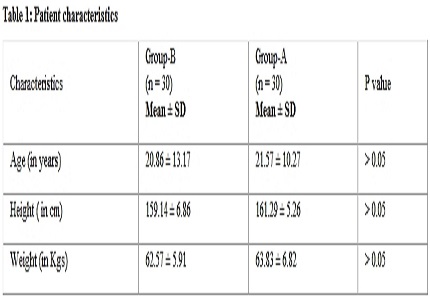To evaluate and compare analgesic effects of wound infiltration with voveron with intravenous injection in cesarean section
Abstract
Objectives: Postoperative pain mostly results from sensitization of afferent fibers at injury sites driving central sensitization. Recently, peripheral processes have gained attention as mechanism of hyperalgesia, and prostaglandins are among highly sensitizing agents. To date, postoperative administration of a one single intravenous dose of voveron has shown inconclusive efficacy. Rather than a single intravenous dose, the current study evaluates the postoperative analgesic effect of local injection of voveron sodium after cesarean delivery.
Methodology: In a prospective randomized, controlled study, 60 patients age group between 18-35 years, scheduled for routine and emergency cesarean surgery were distributed into two groups of 30 patients each. Postoperatively, group [B] was given voveron in wound local injection and group [A] received voveron 75 mg conventionally as intravenous injections. Pain intensity score, onset of analgesia, rescue analgesia doses and overall patient satisfaction score were recorded.
Results: Mean onset of analgesia was 8.31 ± 1.5 min with group A as against 4.23 ± 1.2 min with group B. Pain Intensity (PPI) score ≤ 1 was observed in 78.21% observations belonging to group A and in 50 % observations of group B. Twenty five patients (71.4%) from group A and 30 patients (85.7%) from group B required rescue analgesia. The patient’s feedback was graded as very good or good by 78.5% of the patients in Group-A and 69% patients in Group-B.
Conclusion: Though both drugs are equally safe, Voveron in local wound infusion is faster acting, more potent and efficient analgesic than intravenous. voveron when used for postoperative pain
Downloads
References
2. Brennan TJ. Frontiers in translational research: the etiology of incisional and postoperative pain. Anesthesiology. 2002 Sep;97(3):535-7. [PubMed]
3. Mecklem DW, Humphrey MD, Hicks RW. Efficacy of bupivacaine delivered by wound catheter for post-Caesarean section analgesia. Aust N Z J Obstet Gynaecol. 1995 Nov;35(4):416-21. [PubMed]
4. Heyneman CA, Lawless-Liday C, Wall GC. Oral versus topical NSAIDs in rheumatic diseases: a comparison. Drugs. 2000 Sep;60(3):555-74. [PubMed]
5. Olofsson CI, Legeby MH, Nygårds EB, Ostman KM. Diclofenac in the treatment of pain after caesarean delivery. An opioid-saving strategy. Eur J Obstet Gynecol Reprod Biol. 2000 Feb;88(2):143-6.
6. Siddik SM, Aouad MT, Jalbout MI, Rizk LB, Kamar GH, Baraka AS. Diclofenac and/or propacetamol for postoperative pain management after cesarean delivery in patientsreceiving patient controlled analgesia morphine. Reg Anesth Pain Med. 2001 Jul-Aug;26(4):310-5.
7. Romsing J, Mysager S, Vilmann P, Sonne J, Larsen NE, Ostergaard D: Postoperative analgesia is not different after local versus systemic administration of meloxicam in patients undergoing inguinal hernia repair. Can J Anaesth 2001; 48:978–84.
8. Marret E, Kurdi O, Zufferey P, Bonnet F. Effects of nonsteroidal antiinflammatory drugs on patient-controlled analgesia morphine side effects: meta-analysis of randomized controlled trials. Anesthesiology. 2005 Jun;102(6):1249-60.
9. Kehlet H. Postoperative opioid sparing to hasten recovery: what are the issues? Anesthesiology. 2005 Jun;102(6):1083-5.
10. Rømsing J, Møiniche S, Ostergaard D, Dahl JB. Local infiltration with NSAIDs for postoperative analgesia: evidence for a peripheral analgesic action. Acta Anaesthesiol Scand. 2000 Jul;44(6):672-83.
11. Romsing J, Mysager S, Vilmann P, Sonne J, Larsen NE, Ostergaard D: Postoperative analgesia is not different after local versus systemic administration of meloxicam in patients undergoing inguinal hernia repair. Can J Anaesth 2001; 48:978–84.
12. Møiniche S, Mikkelsen S, Wetterslev J, Dahl JB. A qualitative systematic review of incisional local anaesthesia for postoperative pain relief after abdominal operations. Br J Anaesth. 1998 Sep;81(3):377-83. [PubMed]
13. Rawal N. Incisional and intra-articular infusions. Best Pract Res Clin Anaesthesiol. 2002 Jun;16(2):321-43. [PubMed]
14. Fredman B, Shapiro A, Zohar E, Feldman E, Shorer S, Rawal N, Jedeikin R: The analgesic efficacy of patient-controlled ropivacaine instillation after cesarean delivery. Anesth Analg 2000; 91:1436–40.
15. Mecklem DW, Humphrey MD, Hicks RW. Efficacy of bupivacaine delivered by wound catheter for post-Caesarean section analgesia. Aust N Z J Obstet Gynaecol. 1995 Nov;35(4):416-21.
16. Burian M, Tegeder I, Seegel M, Geisslinger G. Peripheral and central antihyperalgesic effects of diclofenac in a model of human inflammatory pain. Clin Pharmacol Ther. 2003 Aug;74(2):113-20.
17. Buvanendran A, Kroin JS, Berger RA, Hallab NJ, Saha C, Negrescu C, Moric M, Caicedo MS, Tuman KJ. Upregulation of prostaglandin E2 and interleukins in the central nervous system and peripheral tissue during and after surgery in humans. Anesthesiology. 2006 Mar;104(3):403-10.
18. Gordon SM, Brahim JS, Rowan J, Kent A, Dionne RA: Peripheral prostanoid levels and nonsteroidal anti-inflammatory drug analgesia: Replicate clinical trials in a tissue injury model. Clin Pharmacol Ther 2002; 72:175–83.
19. Perkins FM, Kehlet H. Chronic pain as an outcome of surgeryA review of predictive factors. The Journal of the American Society of Anesthesiologists. 2000 Oct 1;93(4):1123-33. [PubMed]
20. Almeida EC, Nogueira AA, Candido dos Reis FJ, Rosa e Silva JC. Cesarean section as a cause of chronic pelvic pain. Int J Gynaecol Obstet. 2002 Nov;79(2):101-4. [PubMed]
21. Nikolajsen L, Sorensen HC, Jensen TS, Kehlet H: Chronic pain following caesarean section. Acta Anaesthesiol Scand 2004; 48:111–6.



 OAI - Open Archives Initiative
OAI - Open Archives Initiative


